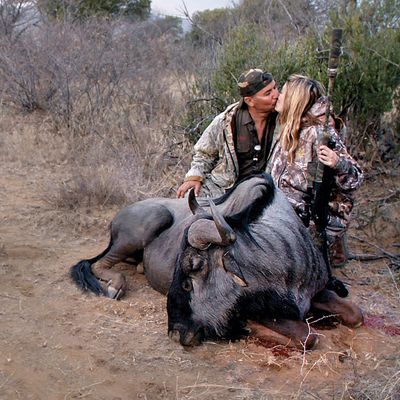
DonÔÇÖt look for a note at the end of the brilliantly ambivalent hunting documentary Trophy attesting that no animals onscreen were injured or killed. The violence against elephants, rhinos, and crocodiles is real and sickening, committed by people who ÔÇö in the opinion of this critic ÔÇö should have the Born Free theme piped into their bedrooms every night until blood streams from their ears and they grovel for forgiveness. But donÔÇÖt look for a blanket condemnation of hunting, either ÔÇö even the ÔÇ£cannedÔÇØ hunting done by rich white people on the plains of poor African countries. And donÔÇÖt expect a diatribe against the international rhino-horn market, however absurd and criminal. Look instead for truths ÔÇö some ugly ÔÇö that canÔÇÖt be reconciled.
Director Shaul Schwarz is best known for his 2013 documentary Narco Cultura, which objectively profiled the celebration in some Latin American quarters of narcotics traffickers ÔÇö violent outlaws who nonetheless symbolize a path out of poverty. As Brecht wrote, ÔÇ£Food is the first thing. Morals follow on.ÔÇØ Our sympathies seesaw in Trophy, too. Consider the second scene, set in a South African rhinoceros ranch owned by John Hume. It begins with a woman shooting a rhino ÔÇö horrible ÔÇö with what turns out to be a tranquilizer gun ÔÇö not so bad ÔÇö before Hume and his men saw off the horn ÔÇö horrible ÔÇö after which Hume asserts he has just saved the rhinoÔÇÖs life, insofar as poachers wonÔÇÖt kill a hornless rhino. An animal doesnÔÇÖt go extinct, Hume maintains, when farmers are able to breed it and make money. And rhino horns grow back. But Hume is in desperate financial straits. In 2009, South Africa banned the sale of rhino horns, and if the ban persists, Hume might have to release his 1,300-plus protected rhinos ÔÇö out of a world population of 25,000.How can he afford to protect them from the poachers responsible for (in a graphic scene) a small field of mutilated rhino corpses?
This is all, to say the least, counterintuitive, but Schwarz and his co-director, Christina Clusiau, give HumeÔÇÖs words a great deal of weight. Later in the film, Hume travels to London to debate Born Free USA CEO Adam Roberts, who decries the containment, confinement, and commodification of animals. The crowd is firmly on his side, and IÔÇÖd have been, too, if there werenÔÇÖt a kind of higher math at work in African conservation. South Africa, conservationist Craig Packer points out, was virtually denuded of wildlife in the late-20th century, and now, as a result of landownersÔÇÖ breeding on private land ÔÇö for conservation and hunting tourism ÔÇö the big cats are back.
Schwarz scrutinizes the hunters dispassionately, as one might any other species. They gather at a sort of watering hole (a Las Vegas convention) to explore their prospects for killing and stuffing big game in the coming year. One half-admires an avid hunter named Philip Glass (not the composer!) for being brave enough to allow Schwarz and Clusiau to photograph him shooting large animals and teaching his young son to do the same. We never, after all, heard from the craven Minneapolis dentist Walter Palmer ÔÇö the bow-and-arrow hunter who in 2015 arranged to lure the beloved Zimbabwe black-maned lion Cecil from a wildlife sanctuary, finished him off, and went into hiding when photos of him posing with Cecil went viral. But Glass is a hard man not to hoot at. He recounts how his mother once told him never to shoot a red bird, after which he promptly went out and shot one. ÔÇ£There is no way,ÔÇØ he says, ÔÇ£I could have loved that bird more, even though it was dead.ÔÇØ Oddly, he attributes this necrophilia to God, who ÔÇ£gave man dominion over the animals,ÔÇØ and adds that touching a dead or dying animal has convinced him that ÔÇ£anybody who believes in evolution is a complete fool.ÔÇØ ItÔÇÖs hard, however, to think of God during the filmÔÇÖs most agonizing scene, in which Glass shoots a young elephant and we hear its dying whimpers. No government bureaucrat, Glass avows, can keep him from his trophy.
It would be easy to despise him, along with a flagrantly rich fellow (unnamed for his own protection, reportedly) who watches a crocodile die and asks his guide, laughing, ÔÇ£How much [did I pay] for that sucker? How much was Cecil?ÔÇØ But this, suggests Trophy, is AfricaÔÇÖs Faustian bargain. The big bucks of assholes underwrite protection from poachers. And how topsy-turvy is it when Schwarz and Clusiau film black families cowering in pools of light from the ÔÇ£black bootsÔÇØ that have busted into their hovels and we find ourselves on the side of the invaders? The black boots are anti-poaching officers ÔÇö led by the affable redhead Chris Moore ÔÇö and the families are those of poachers whose grisly handiwork weÔÇÖve observed. Moore muses sadly that sometimes heÔÇÖs saving animals from poachers so they can be hunted.
ItÔÇÖs too bad that Schwarz and Clusiau donÔÇÖt explore the economics of ecotourism ÔÇö IÔÇÖd love to know if it generates as much revenue as hunting. But I suspect that those figures wouldnÔÇÖt simplify much. Nothing in Trophy shakes out neatly, because everyone onscreen has his or her own set of values and every value is in conflict. The movie is richer in every way for its tangled sympathies. It will leave you angry, sick, and confused ÔÇö but not smug. Never smug.
*This article appears in the September 4, 2017, issue of New York Magazine.


